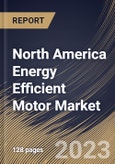Compared to traditional motors, the energy efficient motor consumes less electricity, operates cooler, and lasts longer. This motor is 2-6% more efficient than a regular motor and has more copper windings overall. As a result, the motor has a low working temperature, makes very little noise and vibration, and has a longer lifespan, lowering maintenance costs. It is appropriate for various industrial uses, including paper, textiles, blowers, cement, and machine tools.
Improved manufacturing processes and superior materials, longer bearing lives, higher service factors, lower waste heat output, and reduced vibration are all characteristics of energy efficient motors that promote reliability. More efficient electric motors do so by minimizing losses, which only make up about 3-6% of the energy that passes through the motor. Because of its highly efficient electric motor, a variable speed drive (VSD) can save energy while also lowering pollution. The introduction of the VSD aids in system efficiency optimization.
Efficient electric motors are more cost-effective throughout the system. In contrast, with thousands of hours of operation per year, motor energy expenses often account for a significant percentage of the life-cycle cost of the motor. By utilizing variable speed drives, or VSD for short, an efficient electric motor can reduce the emissions caused by energy savings. The primary function of a variable speed drive (VSD) is to regulate the speed of the motor in response to changes in the load. Also, the VSD improves the effectiveness of the system as a whole.
Cities in Mexico are growing quickly, increasing the need for energy and creating ineffective transportation systems. Currently, the residential sector in Mexico uses around 6% of the nation's total energy and 26% of its total electricity. Sustainable housing, however, calls for investment. By boosting the number of mortgages for low-carbon housing and releasing financing to construct it, government initiatives are helping Mexico combat climate change. The increased efforts to reduce energy use, like in the residential sector, are anticipated to increase demand that may help users drastically reduce their power use and consequently support market expansion in the region.
The US market dominated the North America Energy Efficient Motor Market by Country in 2022 and would continue to be a dominant market till 2029; thereby, achieving a market value of $12,775.1 Million by 2029. The Canada market is poised to grow at a CAGR of 9.5% during (2023-2029). Additionally, The Mexico market should witness a CAGR of 8.5% during (2023-2029).
Based on Application, the market is segmented into HVAC & Pumps, Fans, Compressors, Refrigeration and Material Handling & Material Processing. Based on Efficiency Level, the market is segmented into IE3, IE2, IE1, IE4 and IE5. Based on Power Output Rating, the market is segmented into < 1KW, 1 - 2.2 KW, 2.2 - 375 KW and >375 KW. Based on Type, the market is segmented into AC Motors and DC Motors. Based on End-user, the market is segmented into Industrial, Commercial, Residential, Automotive, Agriculture and Aerospace & Defense. Based on countries, the market is segmented into U.S., Mexico, Canada, and Rest of North America.
The market research report covers the analysis of key stake holders of the market. Key companies profiled in the report include ABB Group, Siemens AG, Toshiba Corporation, Rockwell Automation, Inc., Nidec Corporation, WEG Equipamentos Eletricos SA, Mitsubishi Electric Corporation, Havells India Ltd., CG Power & Industrial Solutions Ltd. (Murugappa Group) and Kirloskar Brothers Limited (Kirloskar Group)
Scope of the Study
By Application
- HVAC & Pumps
- Fans
- Compressors
- Refrigeration
- Material Handling & Material Processing
By Efficiency Level
- IE3
- IE2
- IE1
- IE4
- IE5
By Power Output Rating
- < 1KW
- 1 - 2.2 KW
- 2 - 375 KW
- >375 KW
By Type
- AC Motors
- DC Motors
By End-user
- Industrial
- Commercial
- Residential
- Automotive
- Agriculture
- Aerospace & Defense
By Country
- US
- Canada
- Mexico
- Rest of North America
Key Market Players
List of Companies Profiled in the Report:
- ABB Group
- Siemens AG
- Toshiba Corporation
- Rockwell Automation, Inc.
- Nidec Corporation
- WEG Equipamentos Eletricos SA
- Mitsubishi Electric Corporation
- Havells India Ltd.
- CG Power & Industrial Solutions Ltd. (Murugappa Group)
- Kirloskar Brothers Limited (Kirloskar Group)
Unique Offerings
- Exhaustive coverage
- The highest number of Market tables and figures
- Subscription-based model available
- Guaranteed best price
- Assured post sales research support with 10% customization free
Table of Contents
Companies Mentioned
- ABB Group
- Siemens AG
- Toshiba Corporation
- Rockwell Automation, Inc.
- Nidec Corporation
- WEG Equipamentos Eletricos SA
- Mitsubishi Electric Corporation
- Havells India Ltd.
- CG Power & Industrial Solutions Ltd. (Murugappa Group)
- Kirloskar Brothers Limited (Kirloskar Group)
Methodology

LOADING...








